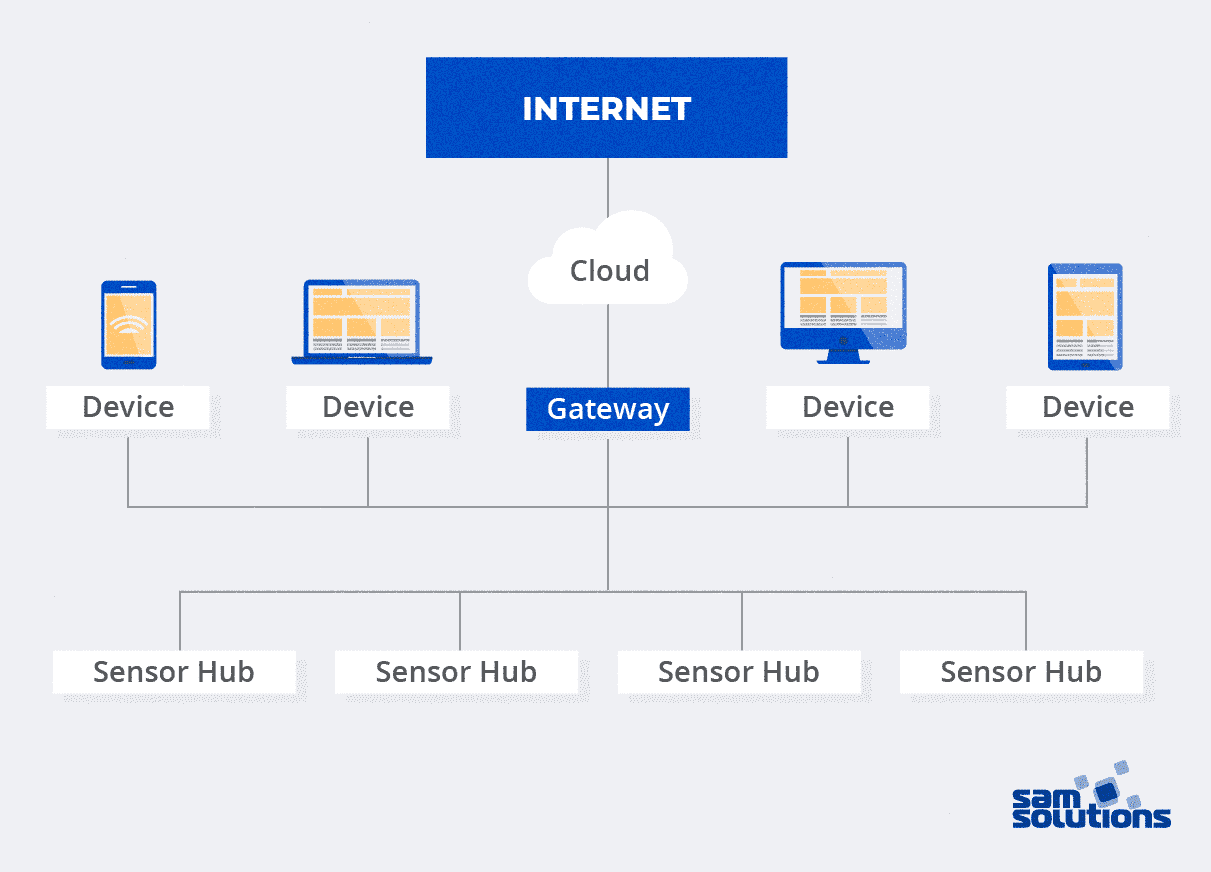Internet-of-Things technologies will penetrate almost all spheres of our daily life and make our lives more comfortable and protected. According to Statista, there will be 30.9 billion active IoT connections by 2025. In this article, we will look at the most popular ways to use IoT technologies in your home and explain what IoT architecture looks like.
Transform your business or gain a competitive advantage in your industry with custom IoT software solutions from SaM Solutions.
Smart Home and IoT
Smart IoT sensors know our tastes, the type of music we like, our preferred temperature and lighting regimes, the time we get up, eat, and go to bed. Devices like smart plugs, lighting and security systems help simplify our routine. They are easily controlled via a smartphone app, so we don’t have to worry about our home security when we are not there. Read on to learn about IoT in smart home automation.
Applications of IoT in Smart Homes

Lighting
Today, home lighting can automatically adjust to personal needs. For instance, if users start watching a movie, the lights can be programmed to automatically dim not to distract them from the plot. When you enter your home, the lighting can be turned on automatically without the necessity to press a button.
When you leave your home, the system can turn the lights off automatically to save energy, and you don’t have to worry about it. All the home lighting can be connected to your smartphone, laptop, and other connected devices. Consequently, you can configure your app so that your light turns on when your alarm rings in the morning.
Bathrooms
IoT technologies in the bathroom can make your home routine more entertaining and convenient. Smart mirrors can connect to other devices like laptops and smartphones, recognize the faces of family members in front of them, and display the information those people find interesting, such as news articles, weather forecasts, or specific websites. Special sensors can monitor movement in the bathroom, and turn off the water automatically if no one is there.
Smart shower controllers can also identify people and set up their preferred water temperature and pressure, and even limit the time in the shower to control water consumption. With automated jacuzzis, users can take a bath without having to manually adjust their preferred temperature and air-jet regime, or select their favorite music, as the app will do all that automatically – all they have to do is to relax and enjoy the bath.
Gardens
For those users who are interested in growing vegetables, fruit, and herbs at home, sensors can be exceptionally beneficial. The technology allows users to check on the app if the temperature is right, and if the plant is properly hydrated and receiving the necessary amount of sunlight.
The app can monitor the current state of the soil, identify if there is enough moisture in it, and turn on a smart irrigation system if needed. When the amount of moisture reaches the optimal level, the sensor detects it and stops the watering system, thus avoiding overuse of water. IoT technology has led to a real breakthrough in gardening, which will completely remodel the traditional approach to growing plants.
Kitchen
With artificial intelligence technology, IoT devices can make the cooking process safer and easier. Smart sensors can ensure that everything is OK in your kitchen: they can check for smoke and carbon monoxide, or that the temperature and humidity levels are right.
Special built-in programs monitor if the users have enough products in the fridge (and reorder them if needed), give advice on recipes, and calculate the nutritional value of meals. There are even smart spoons that remind users to be mindful of eating slowly.
Security Systems
When you leave your home, do you always check that the doors and windows are closed, and that the TV, computer, and electrical appliances are off? Smart security systems will do that for you with the help of special sensors.
These controllers can automatically lock the door when you go out, close the shutters, turn off electronic devices and make sure that your home is protected against human and animal trespassers. Users can check their home state remotely through the app on their phones, and control the temperature, humidity and lighting. Moreover, you can monitor your elderly relatives and help them if needed.
With SaM Solutions’ wide range of IoT services, you get professional support and hands-on assistance at any stage of your IoT project.
Safety Sensors
Safety sensors are smart devices that can identify when there is something wrong at your home. They can notify users of potential threats immediately and even take necessary action to prevent them. All they need is a smartphone connected to the Internet and sensors installed at their home.
There are temperature, humidity, and gas controllers that can regularly check the air in your home and send you alerts on the Internet if the indicators are outside the optimum range. Safety sensors help protect your home from natural disasters, fires, water and gas leakages. Proximity and video sensors can identify if a burglar makes an attempt to enter your home, and automatically turn on the alarm and call the police.
Temperature Control
With temperature control automation, you can adjust the home temperature to the level that suits you best. Smart thermostats control the temperature based on configurations set by users in accordance with their preferences. These controllers can check your current activity and change the temperature accordingly.
For instance, users can configure the app so that when they take a bath or a shower, the temperature would automatically go up. If they decide to work out, practice yoga, pilates, or any other physical activity at home, the temperature will decrease to help keep them cool.
Doors
The doors of our future will not need keys. To unlock your house, the smart door can use facial recognition. Any people that are not recognized as residents at the premises will need to be let in by a resident. The doors can further be programmed to open when you approach your home and close when you leave.
They can further trigger consecutive reactions of other devices in your home. A possible sequence of events is that the entrance door recognizes the allowed users and opens, followed by the light switching on; other doors in the home then open, and the TV and coffee machine are turned on.
Windows
Smart windows can be configured so that they react to the signals from other appliances or to triggering events. You do not have to worry if you have closed the windows when you leave home – the system will check this automatically, and close them if needed.
Windows can close or open at a preset time, and shutters can also open or close depending on the time of day. Thus, the shutters can be lifted in the morning and lowered in the evening. These devices can also respond to weather conditions such as rain, snow, storm, or strong wind.
Home Routine
Al and Ml technologies can control the temperature in your home, the lighting arrangement, or the security system. The technology can offer you news updates, find the information you request on the Internet, send you notifications via the app on the Internet about the purchases you need to make, order you a meal, schedule an appointment, and book you a flight or a hotel.
Moreover, you can check the state of your home automation system from wherever you are. Hence, while going out, visiting your parents or friends, you can open the app and make sure that everything is all right with your lighting, security, and other Internet-connected systems.
How Does an IoT-Based Automation System Work?

Basic Setup
An IoT automation system has a complex architecture that includes remote servers with sensors. The servers are located on the cloud and can manage many sensors at the same time. IoT sensors can use Bluetooth, ZigBee, Wi-Fi, and Z-Wave for communication. The main device in the system is a controller, often referred to as a hub or gateway.
It is connected to the home router via Ethernet. The sensors send and receive commands via this centralized gateway. The gateway then takes this communication to the cloud. This means that all the devices are interconnected, and it is possible to set up a desired sequence of actions. This interconnectedness also makes it possible to monitor IoT devices remotely via an app.
Cloud Connection
The data is stored and maintained in the cloud on the Internet so that you can access IoT devices regardless of your physical location. It is always possible to send commands to the hub no matter how far from home you are. After receiving the command, the hub sends a signal to the sensors, and then the requested action is triggered. Then, the hub updates the device status to provide you with relevant information.
Real-Time Monitoring and Notifications
The hub is connected to the cloud network via the Internet. You can plan triggered action and monitor the updates in the routine schedule. The cloud network gets the input and sends it to the hub. Then, the hub sends it to the sensor, which triggers the action. Afterward, you are immediately notified about the altered status of the system. No changes to your smart equipment will be left unnoticed.
IF This Then That (IFTTT) Integration
You can set up consecutive actions with the help of IFTTT (IF This Then That) integration. The action will be performed only in case IF criteria are fulfilled. For example, if the sensors detect rain or snow, the windows will be closed automatically to protect your home.
IoT Home Sensors for Home Automation
IoT sensors can significantly improve our quality of life and make our homes safer places. Smart motion controllers can identify if someone is approaching your property. They can inform users via the app about any intruders, be they human or animal.
Smart controllers in the network make sure all the windows and doors are closed at night when residents leave home, and during certain weather conditions like rain or storm. Temperature, humidity and lighting can be adapted to your preferences with the help of controllers. With carbon monoxide–detecting sensors, you can prevent carbon monoxide poisoning. Smoke controllers help protect your home from fire threats.
IoT in Home Automation by SaM Solutions
SaM Solutions created an IoT smart pot. With this IoT device, it is easier to care for your plants even if you are not at home. The technology allows you to remotely control and constantly monitor the state of plants and the surrounding environment.
- A rich cloud database with 150+ species makes it possible to tend to the plants based on their individual needs.
- Smart sensors monitor the air quality. If they notice excessive pollution, a unique air purifying method automatically adjusts the air quality to the optimal level.
- The smart pot device guarantees 4–8 weeks of automated watering.
Innovative IoT solutions for your home will help keep your plants safe and healthy while you are on vacation or have no opportunity to care about them.



























 5 Reasons Why Your Business Needs a Mobile eCommerce Application
5 Reasons Why Your Business Needs a Mobile eCommerce Application Using Salesforce to Improve Your Sales Pipeline: Five Tips
Using Salesforce to Improve Your Sales Pipeline: Five Tips Cross-Platform Mobile Development: Five Best Frameworks
Cross-Platform Mobile Development: Five Best Frameworks How to Develop Custom Accounting Software
How to Develop Custom Accounting Software 10 Best Web Development Frameworks in 2024
10 Best Web Development Frameworks in 2024












 Top 30 Ecommerce Tools to Elevate Your Business in 2024
Top 30 Ecommerce Tools to Elevate Your Business in 2024 5 Best Tools to Improve Embedded Software Testing
5 Best Tools to Improve Embedded Software Testing Why React and Node.js Are the Top Technologies for Creating High-Performance Web Apps in 2024
Why React and Node.js Are the Top Technologies for Creating High-Performance Web Apps in 2024 10 Best IoT Platforms for 2024
10 Best IoT Platforms for 2024
Internet of things in home automation growing simultaneously. Applications of IoT in home is the upgraded version and keeps us settled all the time.
This is really informative for me. I’ve been looking for information about IoT in Home Automation for a long time, thanks!
Thanks for sharing a great article with us.
More than anything, I appreciate the home security features. I don’t have to worry if I locked the door when I leave the house in a hurry, as I am sure that the system will do it for me.
Being a plant lover, I am obsessed with IoT technology as it helps me care about my flowers. The smart system I have installed waters them automatically and checks that they’re getting enough light.
I don’t understand why some people are afraid of IoT technologies. Come on, this is the future! If it makes our life easier, why not use it?
It’s a really great article, thanks for sharing such informative knowledge with us.
What an extremely wonderful post this is. Genuinely, perhaps the best post I’ve at any point seen to find in as long as I can remember. Goodness, simply keep it up.
I really enjoy using IoT. It is good to know that my house is protected when I am away. When I am at work or traveling, I can always use the app to check what is going on in my house.
Excellent! IoT is an amazing technology that fits perfectly into my perception of modern interior design solutions. When we think about future technologies, aren’t robots and AI the first thing that comes to mind?
At first, I didn’t trust Internet-of-Things technologies. Cloud storage…didn’t seem secure to me. But when I started using it, I realized that the data was protected – I have never had any issues.
I find it very convenient to have an IoT lighting system at my home. When I go to sleep, the system ensures there are no lights left on. It helps me save on the power bill.